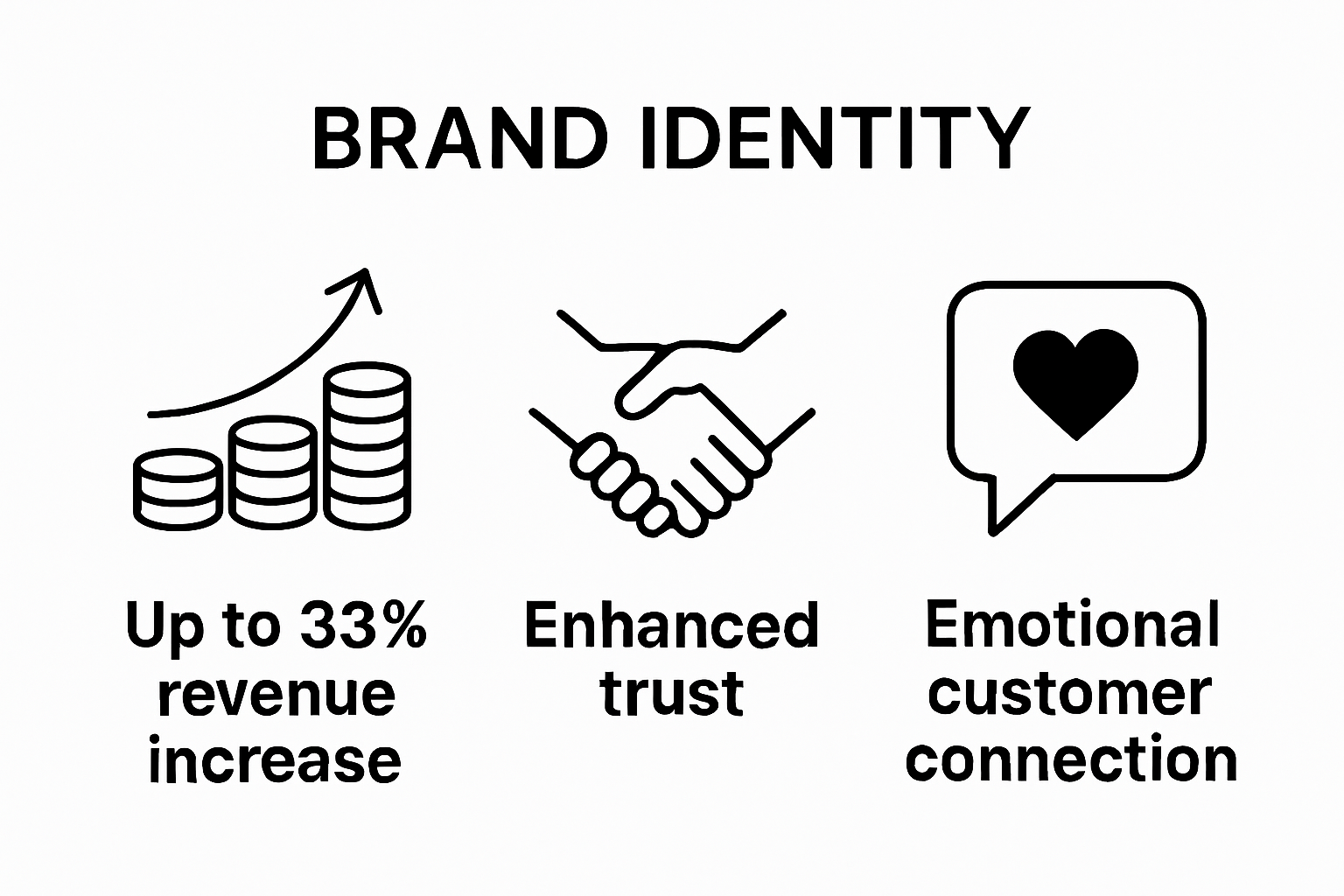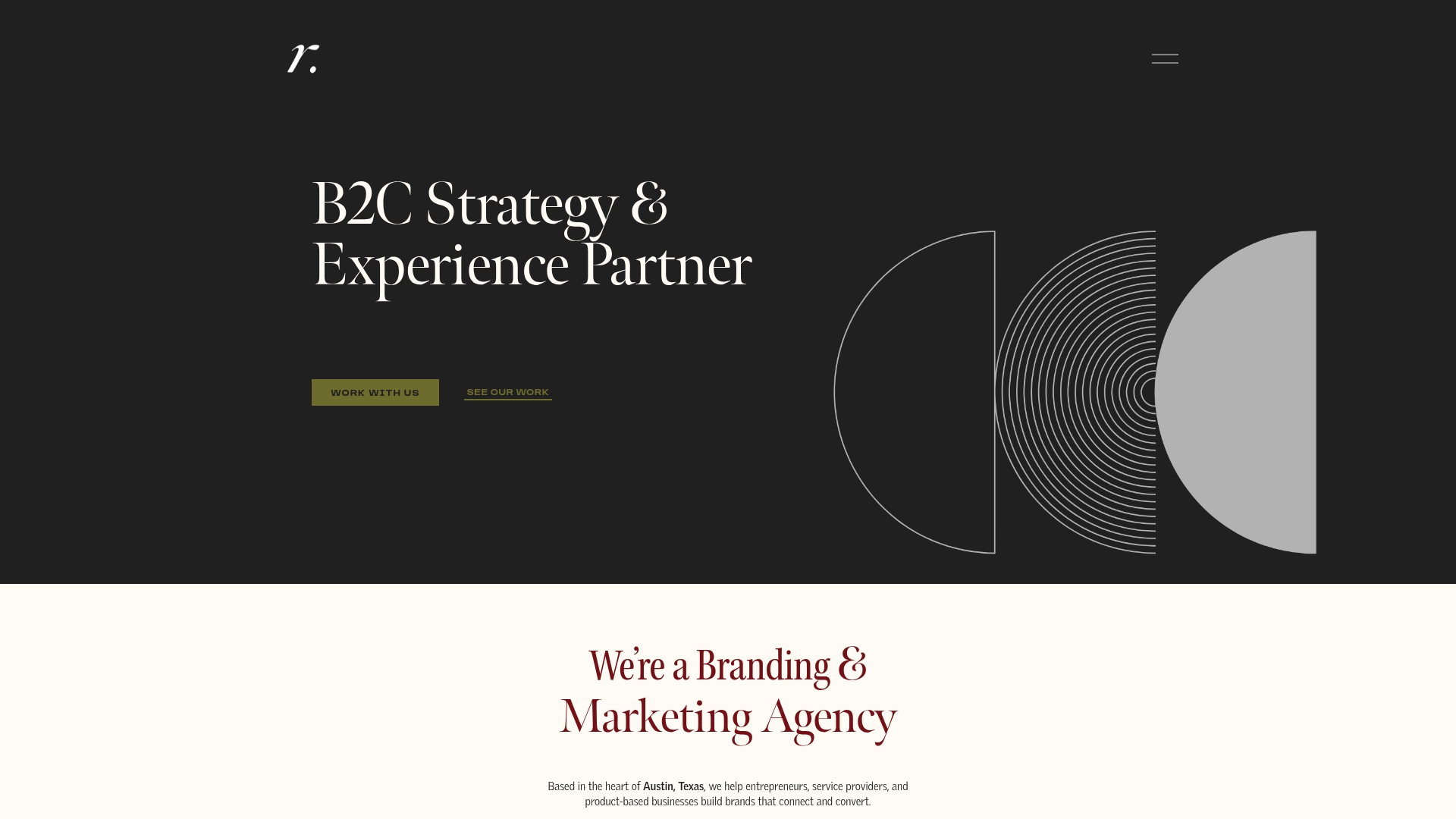How to Increase Brand Visibility with a Proven System

Explore brand identity essentials to clarify your business presence. Learn why it matters and how to build a strong, cohesive identity.

Every business wants to be remembered, but many get lost in the shuffle. Consistent brand presentation can increase revenue by up to 33 percent, according to Lucidpress. You might think a brand is just a logo or a catchy tagline. In reality, your brand identity is a powerful system shaping how people see, trust, and choose your business—and it could be the secret advantage your competitors have not even noticed.
Brand identity represents the comprehensive visual, emotional, and strategic representation of your business that communicates who you are, what you stand for, and how you want your audience to perceive you. Unlike a simple logo or color palette, brand identity is a multifaceted system of design, messaging, and experience that tells your unique business story.
A robust brand identity integrates several critical elements that work together to create a cohesive narrative. These components include your visual design (logo, color scheme, typography), verbal messaging (tone of voice, taglines), and psychological positioning (brand values, personality). Each element acts like a puzzle piece, contributing to the larger picture of how customers understand and connect with your business.
Below is a comparison table summarizing the three core components of brand identity—visual design, verbal messaging, and psychological positioning—to clarify their distinct roles in shaping a business’s brand.
| Component | Description | Key Elements |
|---|---|---|
| Visual Design | The visual foundation that creates first impressions and recognition | Logo, color palette, typography, graphic style |
| Verbal Messaging | The voice and story of the brand that builds resonance | Tone of voice, taglines, core messaging, brand story, value propositions |
| Psychological Positioning | The emotional and strategic blueprint linking audience and mission | Brand values, personality, mission, emotional experience |
Brand identity goes far beyond aesthetic appeal—it’s a strategic business asset that directly influences customer perception and business performance. Research from Lucidpress reveals that consistent brand presentation can increase revenue by up to 33%. This statistic underscores how a well-crafted brand identity can transform your business from being just another option to becoming a memorable, trusted choice in your market.

The power of brand identity lies in its ability to:
Successful brand identity isn’t about looking good—it’s about strategically communicating your business’s core essence in a way that resonates deeply with your ideal customers. Learn more about developing a strategic brand approach that transforms your business communication.
Building a powerful brand identity requires understanding and strategically integrating multiple interconnected components that work together to create a compelling business narrative. These elements are not standalone design choices but carefully orchestrated signals that communicate your business personality and values.
Visual design serves as the first language of brand communication. This foundational element includes critical components like your logo, color palette, typography, and graphic styling. These visual markers are more than aesthetic choices—they’re psychological triggers that communicate professionalism, personality, and positioning. A carefully chosen color scheme can evoke specific emotions, while typography conveys subtleties about your brand’s character, whether it feels modern, traditional, playful, or authoritative.
Beyond visual design, brand identity critically depends on consistent verbal messaging. Your brand’s tone of voice, communication style, taglines, and core messaging create a verbal identity that resonates with your target audience. According to Interaction Design Foundation, these verbal elements must align seamlessly with visual design to create a cohesive brand experience.
The key verbal components include:
The most sophisticated brand identities transcend visual and verbal elements to establish a deeper psychological connection. This involves defining your brand’s core values, mission, and the emotional experience you promise to deliver. Successful brands create an emotional blueprint that goes beyond what you sell and speaks to why you exist. This positioning helps transform customers from mere consumers into passionate brand advocates who feel personally connected to your mission and values.
Through carefully crafted visual, verbal, and emotional elements, your brand identity becomes a powerful communication tool that distinguishes you in a crowded marketplace.
Customer perception is not a passive experience but an active psychological process where every interaction with your brand creates a complex emotional and rational narrative. Your brand identity acts as the primary storyteller, guiding how potential customers interpret and connect with your business through carefully crafted signals and experiences.
Brand identity operates through sophisticated psychological mechanisms that go beyond surface-level aesthetics. Visual elements like color, design, and typography trigger immediate emotional responses that form subconscious judgments about your business. Blue might communicate trust and professionalism, while red can signal excitement or urgency. These instantaneous perceptions happen within milliseconds, influencing whether a potential customer views your brand as approachable, authoritative, innovative, or traditional.
Customers inherently seek brands they can trust, and a consistent, well-designed brand identity serves as a powerful trust-building mechanism. Research from the National Institutes of Health demonstrates that cohesive brand communication significantly enhances perceived credibility. When every touchpoint—from your website to social media to product packaging—communicates a unified message, customers develop a sense of reliability and professionalism.
Key factors that shape customer trust include:
Beyond rational evaluation, brand identity creates emotional pathways that transform transactional relationships into meaningful connections. Customers don’t just buy products; they invest in experiences and identities. A brand that successfully communicates its core values and creates an emotional resonance can convert casual customers into passionate advocates. This deeper connection transcends pricing or features, creating a sense of belonging and shared purpose that drives long-term loyalty.
Through strategic design, consistent messaging, and authentic storytelling, your brand identity becomes a powerful tool for shaping how customers perceive, trust, and ultimately choose to engage with your business.
Consistency transforms brand identity from a collection of disconnected elements into a powerful, unified communication system. It functions as the foundational framework that ensures every interaction with your brand feels intentional, professional, and aligned with your core business narrative.
Consistency creates mental shortcuts for customers, enabling them to quickly recognize and process your brand’s visual and verbal signals. When your brand presents a uniform experience across different platforms and touchpoints, it reduces cognitive friction, making it easier for potential customers to understand and remember your unique value proposition. This psychological phenomenon means that consistent branding acts like a cognitive anchor, helping your business stand out in an increasingly cluttered marketplace.
True brand consistency extends far beyond matching color palettes or using the same logo. It encompasses a holistic approach that synchronizes visual design, messaging, customer experience, and brand values. According to ResearchGate, consistent brand communication significantly enhances brand trust and customer loyalty by creating predictable and reliable brand interactions.
Key areas requiring consistent brand alignment include:
This table outlines the primary areas where brand consistency must be maintained, along with examples and their impact, helping businesses visualize where to focus for a cohesive brand identity.
| Area of Consistency | Description | Example | Impact |
|---|---|---|---|
| Visual Identity | Consistent use of visuals across platforms | Matching colors, logo, and typography | Increases recognition and trust |
| Tone and Voice | Cohesive messaging style and personality | Formal vs. casual language | Ensures clarity and strengthens brand |
| Customer Interaction Protocols | Standardized approaches in customer service | Greeting scripts, problem resolution | Builds reliability and customer loyalty |
| Product/Service Delivery | Predictable quality and experience | Packaging, delivery timelines | Reinforces professionalism and promise |
| Digital & Physical Touchpoints | Uniform presence in all market channels | Website, social media, in-store signage | Eliminates confusion, strengthens image |
Consistency is not a limitation but a strategic advantage. By establishing clear, repeatable brand guidelines, businesses create a robust framework that allows for creative expression while maintaining a recognizable core identity. This approach enables your brand to evolve and adapt without losing its fundamental character. Consistent brands build cumulative brand equity over time, transforming individual interactions into a comprehensive narrative that resonates deeply with your target audience.
Through disciplined and thoughtful consistency, your brand identity becomes a powerful, self-reinforcing communication tool that builds trust, recognition, and long-term customer relationships.
Brand identity is not an abstract concept but a strategic tool that translates core business values into tangible experiences. Successful implementation requires thoughtful integration across multiple business touchpoints, transforming theoretical principles into practical, measurable outcomes that drive customer engagement and business growth.
Visual brand identity serves as your business’s silent ambassador, communicating complex narratives through carefully designed elements. Every design choice—from color psychology to typography selection—becomes a strategic communication channel. A well-designed logo does more than look appealing; it encapsulates your brand’s personality, values, and professional approach. Professional designers understand that visual elements are not decorative but functional communication tools that instantly convey your brand’s unique positioning.
Brand identity extends far beyond marketing materials, becoming a comprehensive operational strategy that influences internal processes and external interactions. This holistic approach ensures that your brand’s core values are consistently reflected in every customer touchpoint. According to Forbes, successful brand integration requires alignment across customer service, product development, employee training, and external communication channels.
Practical integration strategies include:
Quantifying brand identity’s effectiveness transforms it from a creative exercise into a strategic business asset. Modern businesses can track brand identity performance through sophisticated metrics that measure customer perception, engagement, and loyalty. These metrics help organizations understand how their visual and verbal branding translates into real-world business outcomes, enabling data-driven refinement of brand strategy.
By treating brand identity as a dynamic, measurable system, businesses can create powerful communication frameworks that not only attract customers but build lasting, meaningful connections that drive sustainable growth.

If your brand looks professional but customers still hesitate or mix you up with competitors, the problem may not be your logo—it is likely your brand identity is not communicating the full story. The article explained how visual consistency, messaging, and emotional connection shape customer perception and trust. Still, knowing what matters and knowing how to implement it are two different things. Many small business owners try to piece together strategy on their own, only to see confusion in the market and wasted marketing spend. Your next move should be purposeful, not another guessing game or throwaway campaign.

You can make your brand identity work smarter starting today. Reasonate Studio uses The Aligned Impact Model™ to take the puzzle pieces—your story, values, and business goals—and build a brand system that actually resonates with the right audience. Say goodbye to scattered efforts and guesswork. Visit our home page to see how strategy, design, and reliable frameworks transform your brand into a growth engine. The sooner your brand identity aligns with your ambitions, the sooner you stand out in your market. Connect with us and start closing the gap between intention and impact.
Brand identity consists of several key elements, including visual design (logo, color scheme, typography), verbal messaging (tone of voice, taglines), and psychological positioning (brand values, personality). Each component contributes to how customers perceive your business.
Brand identity is crucial as it influences customer perception and business performance. Consistent brand presentation can lead to increased revenue, create immediate recognition, build emotional connections, differentiate your business in the market, and establish credibility.
Brand identity shapes customer perception by acting as a storyteller that guides how customers interpret and connect with your business. It influences emotional and rational narratives through visual elements and standardized messaging, fostering trust and creating lasting impressions.
Consistency is essential in brand identity because it transforms various design and messaging elements into a unified system. A consistent brand experience reduces cognitive friction, enhances recognition, and builds trust, ensuring that all customer interactions feel intentional and aligned with the brand’s core values.